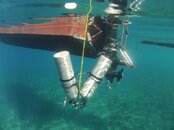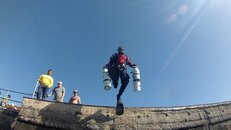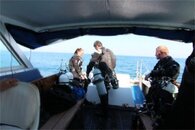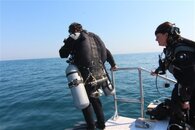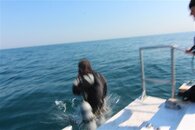SWAMPY459
Contributor
I know everyone does things a little different but in the interest of getting ideas, could everyone post the sequence of events in their entry... like what you do outside the water, what you do at the surface with your face out of the water, what you do with a reg in your mouth and face under water, etc.
I've previously been trying to kit up comletely and giant stride with a negative entry, I know it's a more difficult way (a royal pain in the bum really) , but I am planning a couple of boat dives in the near future so that's what I've been working on.
I saw a video on youtube where a guy did an entry into rough surf where he put on mask, fins, bc, everything except tanks, then clipped only the tank neck leashes and did everything else well away from shore but at the surface
I'm leaning towards trying this sequence of events my next dive:
1. put on bc, mask snorkel, fins
2. clip both tank neck leashes
3. attach low pressure inflator
4. stick left hand (short hose) reg in my mouth
5. Hop into the water face down breathing from reg
6. clip bottom tank clips on waist d ring
7. route right hand long hose around neck and clip right reg to d ring
8. clip off bungies last
9. begin dive
(or would you do all of the above, but at step 5, get buoyant and do all of the clipping off and bungie clipping vertical with your face out of the water?)
What is your preferred sequence of events in your entry?
Thanks in advance,
Swampy
I've previously been trying to kit up comletely and giant stride with a negative entry, I know it's a more difficult way (a royal pain in the bum really) , but I am planning a couple of boat dives in the near future so that's what I've been working on.
I saw a video on youtube where a guy did an entry into rough surf where he put on mask, fins, bc, everything except tanks, then clipped only the tank neck leashes and did everything else well away from shore but at the surface
I'm leaning towards trying this sequence of events my next dive:
1. put on bc, mask snorkel, fins
2. clip both tank neck leashes
3. attach low pressure inflator
4. stick left hand (short hose) reg in my mouth
5. Hop into the water face down breathing from reg
6. clip bottom tank clips on waist d ring
7. route right hand long hose around neck and clip right reg to d ring
8. clip off bungies last
9. begin dive
(or would you do all of the above, but at step 5, get buoyant and do all of the clipping off and bungie clipping vertical with your face out of the water?)
What is your preferred sequence of events in your entry?
Thanks in advance,
Swampy




